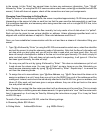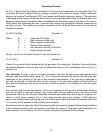24
This reduces to: P
a
V
a
/
Z
a
T
a
= P
s
V
s
/
Z
s
T
s
, eliminating R and n.
Our mass ow meters model gas ows based upon the non-ideal gas characteristics of the calibrated
gas. The ow corrections are normally made to 25 C and 14.696 PSIA and the compressibility factor
of the gas under those conditions. This allows the user to multiply the mass ow rate by the density of
the real gas at those standard conditions to get the mass ow rate in grams per minute.
Because we incorporate the compressibility factor into our ‘full gas model’; attempts to manually
compute mass ows from only the P, V, and T values shown on the display will sometimes result in
modest errors.
Note: Although the correct units for mass are expressed in grams, kilograms, etc. it has become standard
that mass ow rate is specied in SLPM (standard liters / minute), SCCM (standard cubic centimeters
/ minute) or SmL/M (standard milliliters / minute).
This means that mass ow rate is calculated by normalizing the volumetric ow rate to some standard
temperature and pressure (STP). By knowing the density at that STP, one can determine the mass ow
rate in grams per minute, kilograms per hour, etc.
STP is usually specied as the sea level conditions; however, no single standard exists for this
convention. Examples of common reference conditions include:
0°C and 14.696 PSIA
25°C and 14.696 PSIA
0°C and 760 torr (mmHG)
70°F and 14.696 PSIA
68°F and 29.92 inHG
20°C and 760 torr (mmHG)
M Series Flow Meters reference 25ºC and14.696 PSIA (101.32kPa) - unless ordered otherwise.
Refer to the calibration sheet to conrm the reference point.
Standard Gas Data Tables: We have incorporated the latest data sets from NIST (including their
REFPROP 7 data) in our products’ built-in gas property models. Be aware that calibrators that you may
be spot checking against may be using older data sets such as the widely distributed Air Liquide data.
This may generate apparent calibration discrepancies of up to 0.6% of reading on well behaved gases
and as much as 3% of reading on some gases such as propane and butane, unless the standard was
directly calibrated on the gas in question. As the older standards are phased out of the industry, this
difference in readings will cease to be a problem. If you see a difference between the meter and your in-
house standard, in addition to calling Apex, call the manufacturer of your standard for clarication as to
which data set they used in their calibration. This comparison will in all likelihood resolve the problem.


















